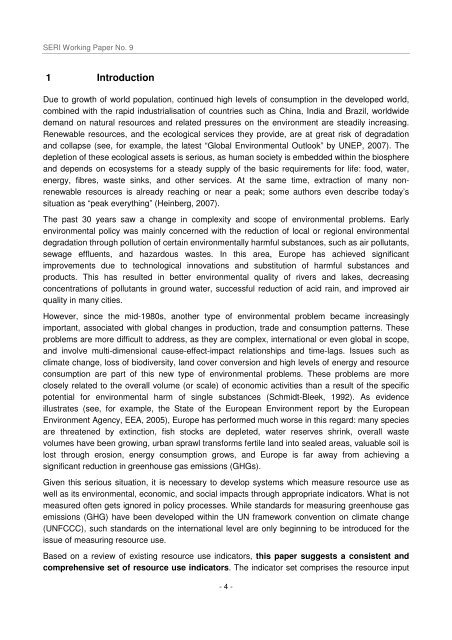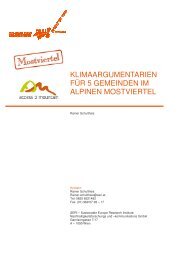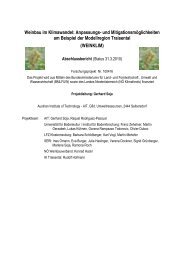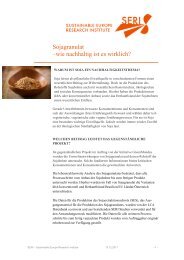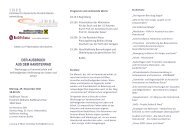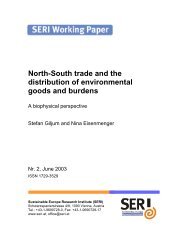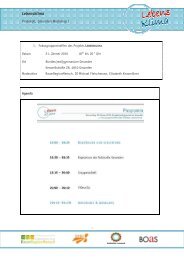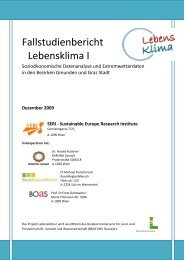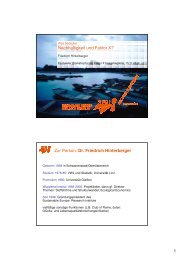Download PDF - Sustainable Europe Research Institute
Download PDF - Sustainable Europe Research Institute
Download PDF - Sustainable Europe Research Institute
Create successful ePaper yourself
Turn your PDF publications into a flip-book with our unique Google optimized e-Paper software.
SERI Working Paper No. 9<br />
1 Introduction<br />
Due to growth of world population, continued high levels of consumption in the developed world,<br />
combined with the rapid industrialisation of countries such as China, India and Brazil, worldwide<br />
demand on natural resources and related pressures on the environment are steadily increasing.<br />
Renewable resources, and the ecological services they provide, are at great risk of degradation<br />
and collapse (see, for example, the latest “Global Environmental Outlook” by UNEP, 2007). The<br />
depletion of these ecological assets is serious, as human society is embedded within the biosphere<br />
and depends on ecosystems for a steady supply of the basic requirements for life: food, water,<br />
energy, fibres, waste sinks, and other services. At the same time, extraction of many nonrenewable<br />
resources is already reaching or near a peak; some authors even describe today’s<br />
situation as “peak everything” (Heinberg, 2007).<br />
The past 30 years saw a change in complexity and scope of environmental problems. Early<br />
environmental policy was mainly concerned with the reduction of local or regional environmental<br />
degradation through pollution of certain environmentally harmful substances, such as air pollutants,<br />
sewage effluents, and hazardous wastes. In this area, <strong>Europe</strong> has achieved significant<br />
improvements due to technological innovations and substitution of harmful substances and<br />
products. This has resulted in better environmental quality of rivers and lakes, decreasing<br />
concentrations of pollutants in ground water, successful reduction of acid rain, and improved air<br />
quality in many cities.<br />
However, since the mid-1980s, another type of environmental problem became increasingly<br />
important, associated with global changes in production, trade and consumption patterns. These<br />
problems are more difficult to address, as they are complex, international or even global in scope,<br />
and involve multi-dimensional cause-effect-impact relationships and time-lags. Issues such as<br />
climate change, loss of biodiversity, land cover conversion and high levels of energy and resource<br />
consumption are part of this new type of environmental problems. These problems are more<br />
closely related to the overall volume (or scale) of economic activities than a result of the specific<br />
potential for environmental harm of single substances (Schmidt-Bleek, 1992). As evidence<br />
illustrates (see, for example, the State of the <strong>Europe</strong>an Environment report by the <strong>Europe</strong>an<br />
Environment Agency, EEA, 2005), <strong>Europe</strong> has performed much worse in this regard: many species<br />
are threatened by extinction, fish stocks are depleted, water reserves shrink, overall waste<br />
volumes have been growing, urban sprawl transforms fertile land into sealed areas, valuable soil is<br />
lost through erosion, energy consumption grows, and <strong>Europe</strong> is far away from achieving a<br />
significant reduction in greenhouse gas emissions (GHGs).<br />
Given this serious situation, it is necessary to develop systems which measure resource use as<br />
well as its environmental, economic, and social impacts through appropriate indicators. What is not<br />
measured often gets ignored in policy processes. While standards for measuring greenhouse gas<br />
emissions (GHG) have been developed within the UN framework convention on climate change<br />
(UNFCCC), such standards on the international level are only beginning to be introduced for the<br />
issue of measuring resource use.<br />
Based on a review of existing resource use indicators, this paper suggests a consistent and<br />
comprehensive set of resource use indicators. The indicator set comprises the resource input<br />
- 4 -


